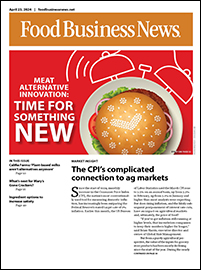Processing considerations
Another key consideration is moisture. The movement of moisture can go in both directions, inclusion to meat matrix or meat matrix to inclusion. Too much movement in either direction results in product breakdown.
“From a processing and formulation perspective, it is crucial to consider the moisture that the inclusion will add to the meat matrix,” Ms. Wetzel said. “Fruits, vegetables and cheeses all have varying moisture levels that can impact the final bite and bind of a sausage.”
With some ingredients and manufacturing techniques, moisture is part of the flavoring process. For example, chefs for a long time have soaked sausages in alcohols, wines and liquors to add flavor, according to Scott Walnofer, director of culinary at Kerry.
“New-generation butchers are bringing this technique back in a new way,” he said. “Combinations like Riesling-soaked apricots or brandy-spiked apples are making their way into everyday retail sausages.”
The moisture of cheese, in particular, can severely impact product quality. But because cheese is a great way to add flavor, color and even texture to sausages, it is an increasingly common inclusion.
Current clean-label trends are to use natural cheese, as it is minimally processed and typically contributes very simple ingredients to the final product, just milk, salt, culture and enzyme. However, process cheese typically performs much better in cooked sausages.
With natural cheese, you get flavor and mouthfeel, but melt properties are not as good, and you typically will not get cheese particulate identity in the final cooked sausage. Because piece identity is important to many consumers, processors should stuff the sausage very soon after adding the cheese to the meat matrix. This is because when cheese is added to meat, it starts to disintegrate.
The water activity of the sausage and the cheese, plus the melting point of the cheese are two very important items to consider when choosing a cheese inclusion for sausage. Preventing moisture migration between the sausage and cheese is important to the integrity of the cheese texture. You can minimize moisture migration by selecting a variety of cheese that has a water activity or moisture content close to that of the sausage product.
Cold melt is the result of moisture moving from the sausage into the cheese piece. This is more prevalent with natural cheese pieces, with the result being soft, mushy cheese, which, when heated, oozes out of the sausage and is no longer identifiable.
Process cheese products can be designed to not absorb moisture as well as have restricted melt. Process cheese manufacturers can alter the melt of the cheese by the amount and type of phosphate emulsifiers they use to dial in the right amount of cheese melt and texture that works best for each application. There are a few natural cheeses with restricted melts, including paneer, queso blanco, feta, halloumi and juustoleipa.




